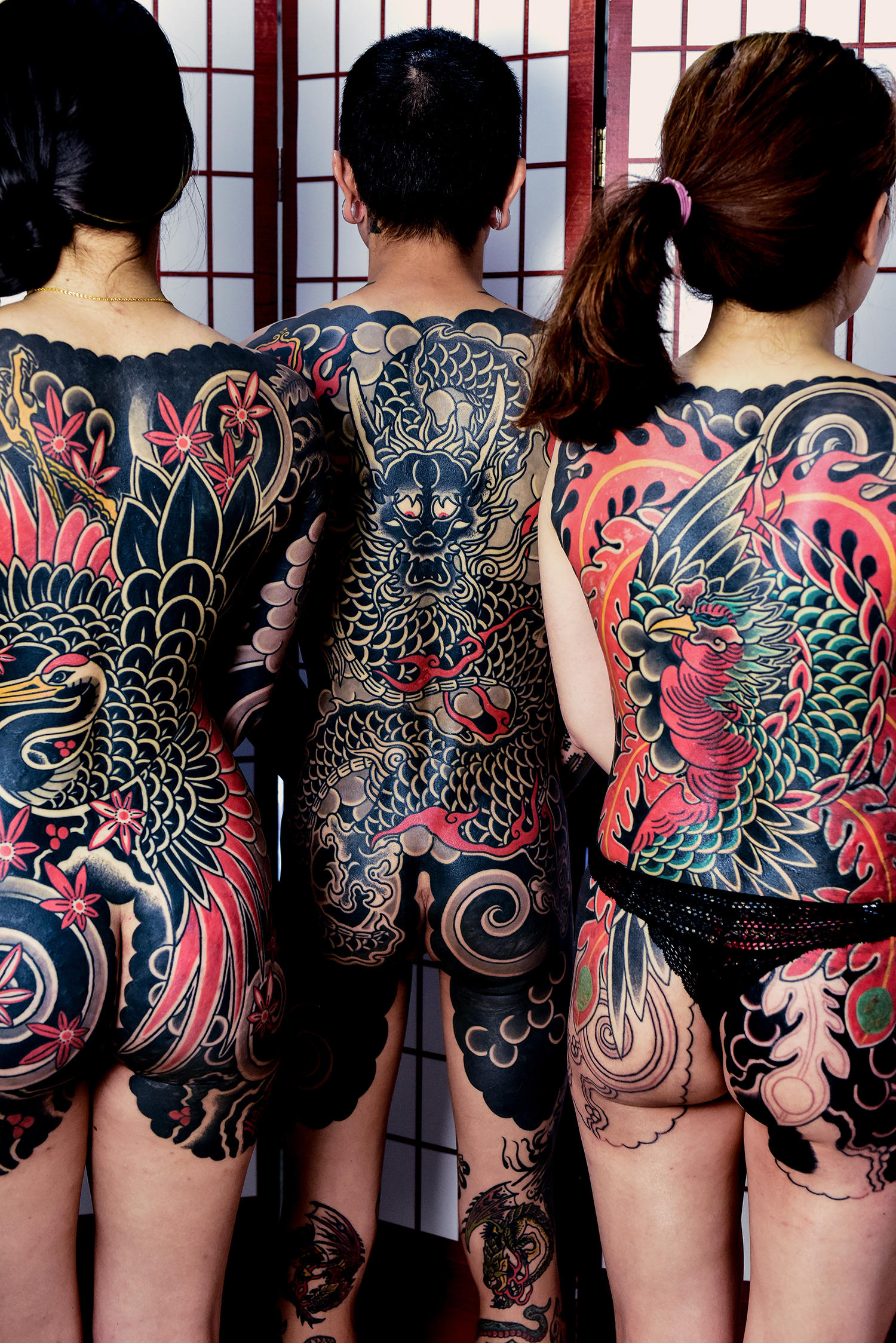
Shane Tan was born in Singapore in 1984 and has had a passion for tattooing since he was a child. His immediate family members had tattoos, and they were acquainted with first- and second-generation tattoo artists. Tan’s father bought him a coil machine for his sixteenth birthday, which he taught himself how to operate. Spending decades perfecting his craft, starting with inking buddies at his parents’ home and eventually becoming a professional tattooist in 2000.
Tan is now regarded as one of Singapore’s finest tattoo artists, specializing in the Japanese style—his work is bold and minimalist in its use of color. To ensure the best possible outcome for the customer and the longest possible duration of the composition on the body, he prioritizes quality over quantity.
Above: The tattoos depict the following themes: Tsuru (crane), Ryu (dragon), and Hou-Ou (phoenix).
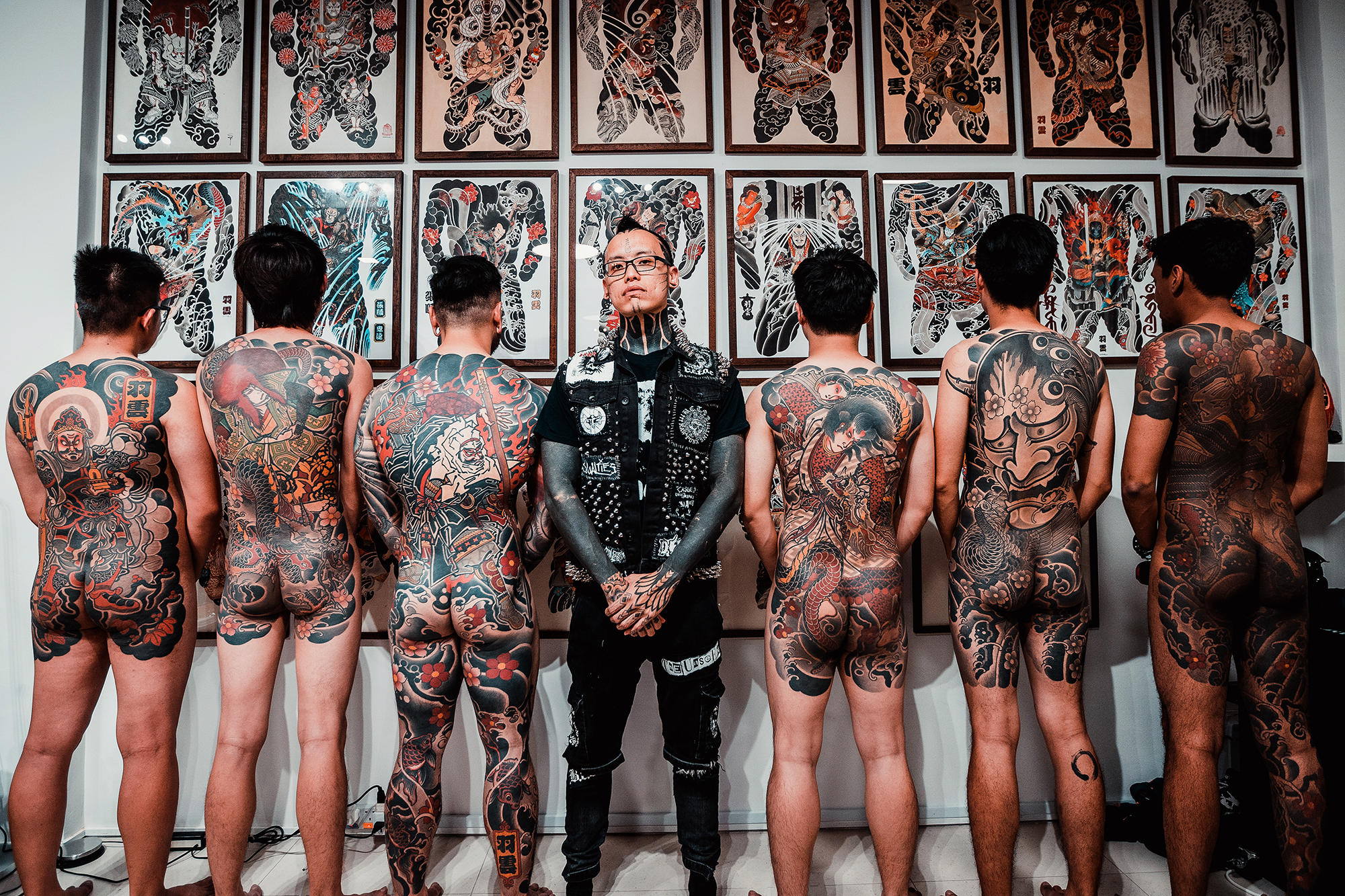
Shane Tan’s bodysuits and back pieces collection.
Black and red inks are used in a large portion of your portfolio. Would you please explain your creative approach and how long it took you to develop this distinctive style?
After a decade of aging, the multi-colored tattoos I did more than 10 – 15 years ago were no longer visually appealing. Some lighter tones became murky and weak, much contrast was lost, and everything appeared too muted, but don’t get me wrong: I’m not saying colors won’t work. I’m just pointing out a few colored pieces that have caused some confusion and doubt about my personal color preferences. I realized that pieces with many colors lost a lot of their impact after a while, even though I was always careful when working with colored pigments and used the best pigments I could get my hands on. Of course, some remained vibrant even after decades of aging; however, limiting the use of colors ensures that my work’s boldness and visual impact last a lifetime. It took me about 15 years to finally be firm and decide on this.
I applied something that worked 200 years ago to my approach. Most of the bodysuits in Ukiyo-e master Kuniyoshi’s depictions of tattooed warriors from his Suikoden series, circa 1827-1830, were in (blue-ish) black and red or “Shu,” which is a shade between red and orange. Along with many others by Kunisada and other woodblock print artists, these images were instrumental in inspiring the first generation of Japanese tattoo artists. The exquisite work of legendary masters Horiuno and Horibun is a prime example. Although some “Old Style” tattooers used brown, green, and yellow in their work, black and Shu were the most common combination. As a lifelong student of Japanese style, it is natural for me to be drawn to these color combinations and incorporate them into my current work after years of experimenting with various approaches. On a side note, I still use primary colors from time to time, but I make sure the background is entirely black to bring out the colors.
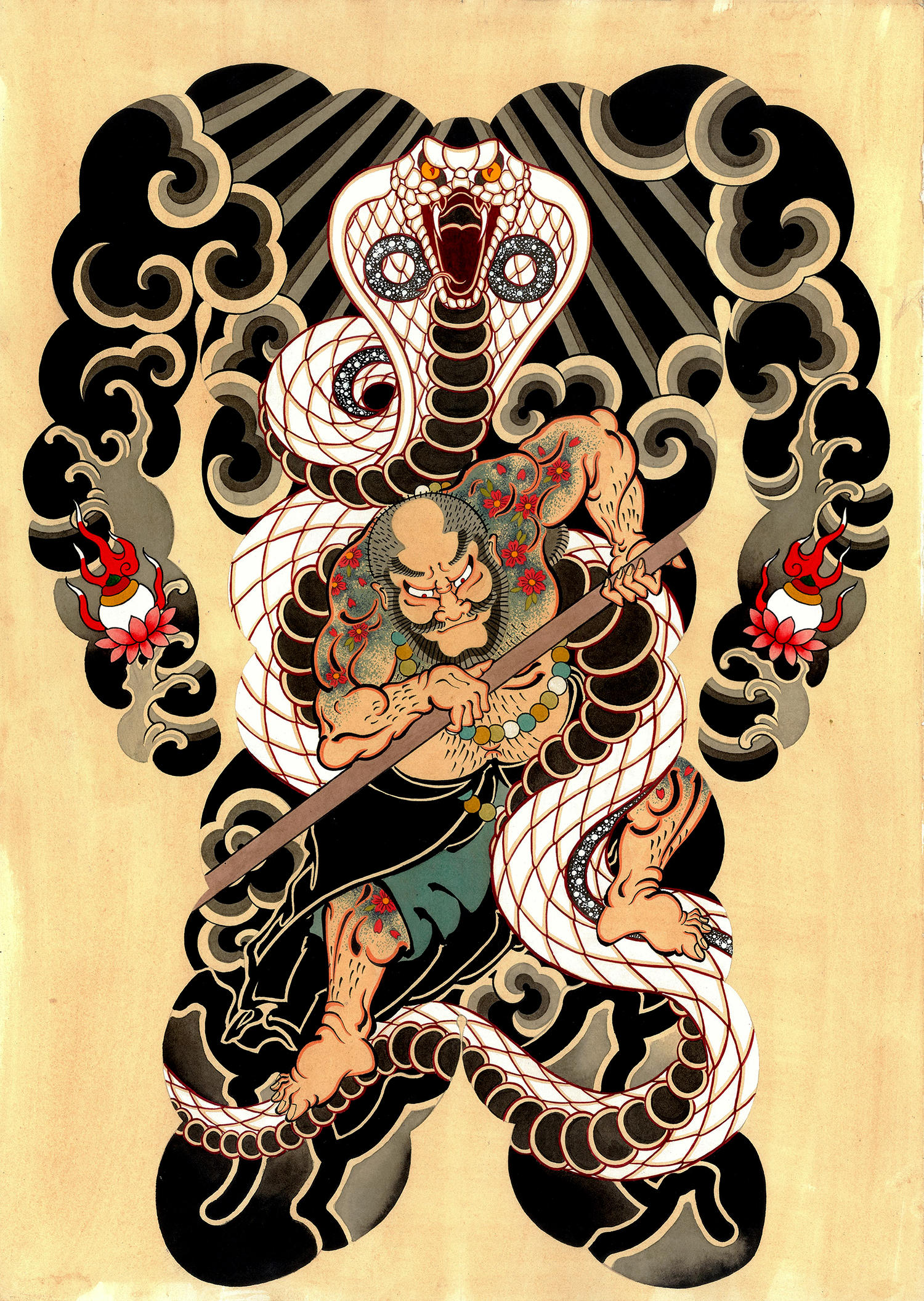
Titled “Kaosho Rochishin” — watercolor, acrylic, and India ink on paper.
Bodysuits undoubtedly have a wow effect; did you begin working on large-scale pieces due to your difficulties with micro tattoos?
I’ve had various issues with large and micro tattoos, but micro tattoos drive me crazy, and I’m shit at them! The main benefit of working with larger tattoos is making minor mistakes and then cleaning them up. It’s not something I do on purpose, but it happens to the majority of us. We are not perfectionism-programmed robots. When I’m working on a back piece or a suit, I’m not concerned if a line is slightly inconsistent because I know I can quickly go back and fix it without compromising the overall quality of the piece. Minor changes will most likely be much more visible with micro tattoos. I’ve never been able to complete a clean small piece that I’m completely satisfied with. There’s no room for error because the spotlight is on one tiny specific area; I tend to spot the tiniest mistakes that others don’t see. When we look at large-scale pieces, we are less concerned with a specific location. Our eyes move around and visit different areas of the body.
Another reason is that there is nothing more rewarding in my career than seeing a group of people wearing my bodysuits and back pieces standing together, interacting, sharing stories of their journey, and very often forming lifelong friendships.
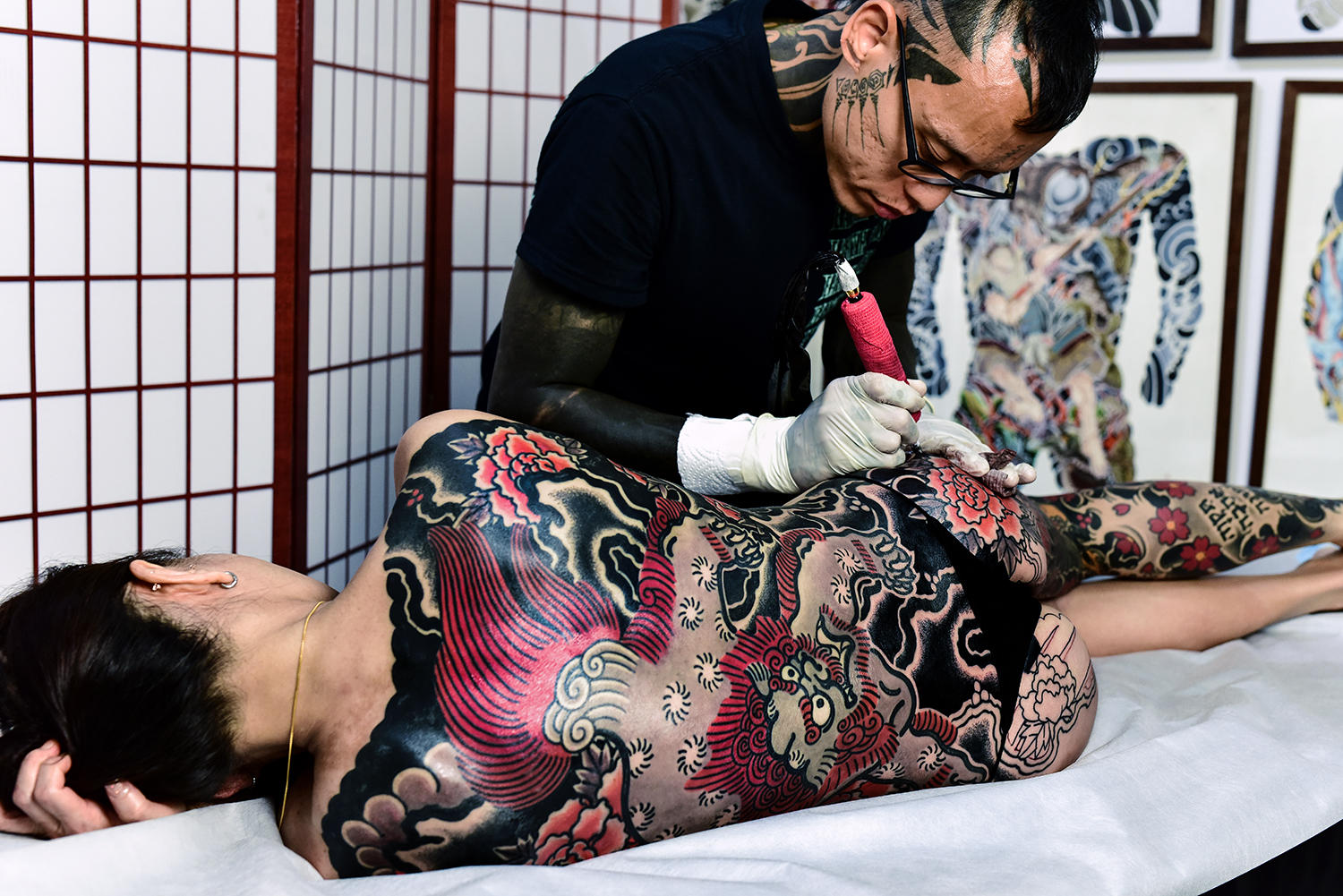
The artist working on a “Karajishi Botan” suit.
You freehand your background designs. Could you perhaps elaborate on the significance of backgrounds in Japanese tattooing?
In Japanese tattooing, the background is just as important as the main subject. The background gives the tattooer a distinct identity and reveals how experienced they are. The way a Japanese tattooer constructs his background is his trademark. It is the soul of all Japanese tattoos. When I study “Old Style” of tattoos, I always analyze and admire the background before moving on to the main subject. It’s much easier to figure out how to draw the main subject than it is to figure out how to draw the perfect background for each body part. It took me years to figure out how to combine different elements and apply them to the body without making strange mistakes.
We frequently see main subjects that are flawlessly executed, but a lack of proper background ruins the entire piece. The Japanese background is created by interpreting nature in various forms, bringing the main subject to life. The raw energy of crashing waves against rocks creates constant momentum and movement. The elegant and dynamic clouds forming whirlwind spirals enhance the body’s contours beautifully. The depths create balance, unity, and ever-changing variations of waterfalls interacting with or overlapping koi, goldfish, and other mythical creatures. […] The use of black in each element provides ideal support and visibility for the main subject. An entire piece will be disastrous if it lacks the proper background, whether the sky, earth, water, fire, or a mix of everything. Everything falls apart without adequate support, no matter how well or fancy the main subject is. The setting is everything. There would be no such thing as a Japanese bodysuit if it did not exist.
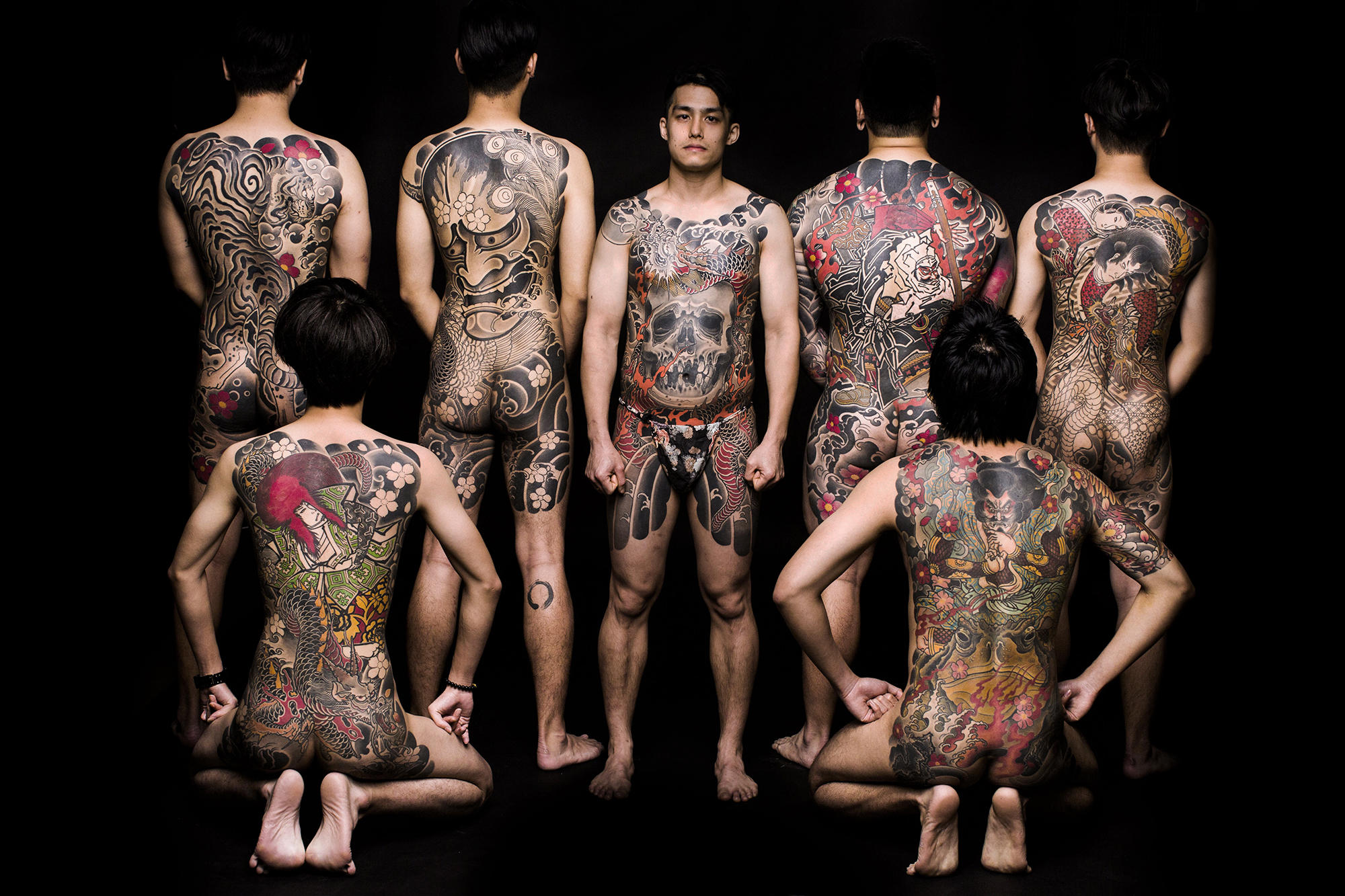
Shane Tan’s chest and back tattoos; photograph by JANA YAR.
How long does it typically take to create a bodysuit?
I’d estimate that it would take me around 250 hours to complete a bodysuit. I’m not a quick tattooer. I used to work much faster when I was younger, but I’ve slowed down a bit over the years because I stopped using large magnums (23 or more). When I use a smaller magnum to pack in the pigments, I get better saturation. And, on occasion, I do the black twice if I feel it isn’t up to my standards. I take great care not to rush anything so that the result is not compromised. Even if a back piece takes twice as long as usual, I’d do it and explain to my client that this is the only way to get the best results.
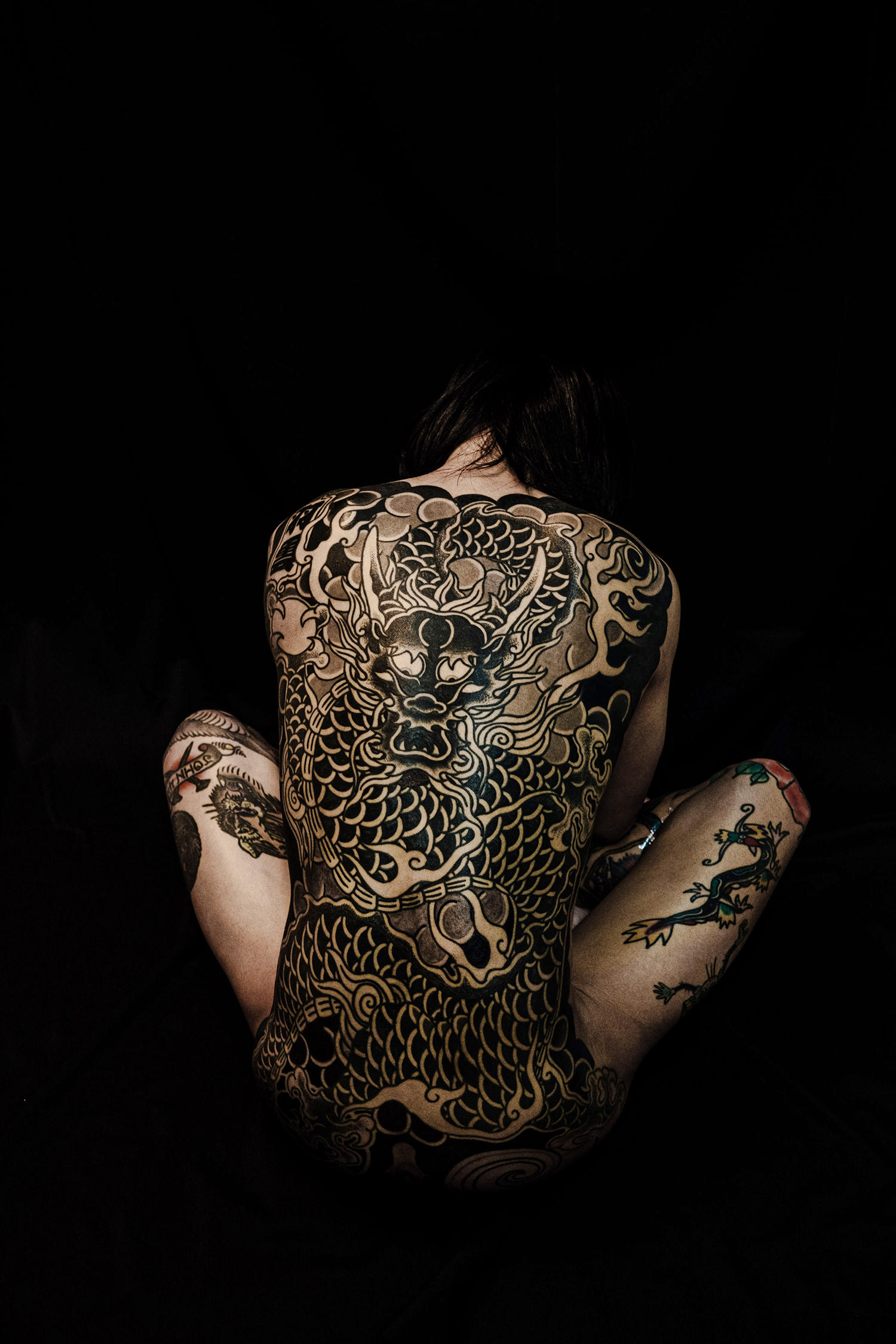
Dragon, a work in progress that still requires red coloring.
You previously likened yourself to Sid Vicious, saying, “I know I lack a lot of talent, so I make up for it with pure desperation and determination.” How is this possible?
Sid Vicious was a horrible bassist, but he made up for it by being an “amazing” performer. He knew he couldn’t make it as a proper musician, so he went ahead and made a name for himself as the most provocative and destructive performer (of that time) to achieve the unachievable. Many people find it ridiculous and unworthy to glorify Sid because of his destructive lifestyle, leading to his early death. Still, you have to give it to him. Despite not playing an instrument or singing properly, he became one of the most prominent punk icons. He desired it so much that he found a way to make it happen against all odds. He’s usually dismissed as “unlucky” and that he became the face of punk by chance, but if you think about it, that guy did anything and everything to gain popularity. He knew the audiences were expecting something they’d never seen before, so he gave it to them at any cost.
Of course, I’m not directly following his footsteps because I don’t seek fame in music and am not required to perform. Still, in some weirdly similar ways, I put myself through very harsh and destructive situations at the beginning of my career and defied many people. Even initially, I had to think of ways to be visually provocative while remaining closely connected to traditional tattooing. To protect me, I knew I had to be loud and aggressive. I couldn’t care less what other people thought of me. Because I was too young, I was never accepted into the Singapore tattoo scene. I had to force my way around people who were more than ten years my senior and were constantly trying to put me down. I began tattooing at the age of 16, and I was treated like dirt by many of the scene’s older and more hostile tattooers. This was 21 years ago, and the scene was very different from today’s, particularly in Singapore. There were only a few shops, and everyone despised one another. But I was determined to get in, so I was stubborn and relentless.
I’ve never thought of myself as a good artist because I lack the gift and talent, or whatever you want to call it. I’ve been drawing since I was 4 or 5 years old, but I’m still not as good as I’d like to be. So I used sheer desperation and determination to achieve my goal. I put in more hours than anyone else I knew. I stayed up all night drawing while everyone else slept, then went to work the next day without any sleep or rest, and continued this daily until I became sick or my body broke down. When I say I “lack talent,” I don’t have that special gift to create something I imagine effortlessly. Even if I’ve drawn something countless times, I usually have to draw it four or five times before figuring it out. I recently drew a back piece design seven times before I was satisfied with it.
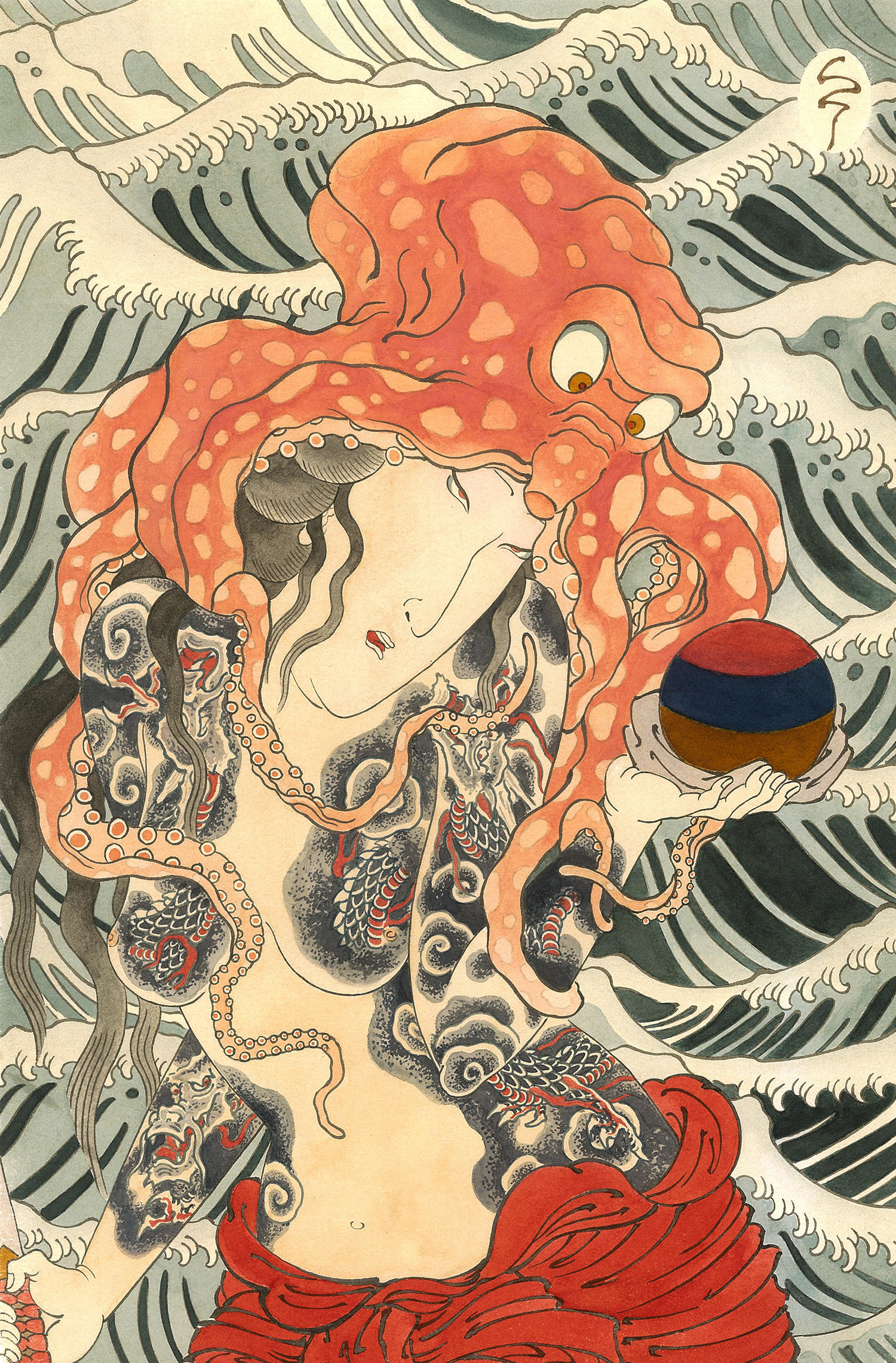
“Tamatori Hime,” watercolor and India ink on paper.
You are a perfectionist. What are some of the mental processes you go through that your customers and admirers are unaware of?
I am obsessed with drawing! I take a lot of references from the old masters, copying, studying, and analyzing every detail to understand their thought processes and apply it to my drawing techniques. I visualize something, and I desperately want to achieve it, even if it takes ten tries. It makes no difference whether it takes weeks or months to figure out a single design.
During the creative process, I tend to overthink a lot. In my head, there is a never-ending hurricane. At times, I find myself going in circles, doubting and pondering the various approaches I take. I’m thankful that I’ve gained more confidence over the years and that I’m a little calmer than I used to be. It comes with time, but I’m still worried that I’m not producing the quality and quantity of work I want. It’s quite normal, I believe. Creative people tend to be a little crazy and unreasonable. That’s why I drive to learn and to push myself.
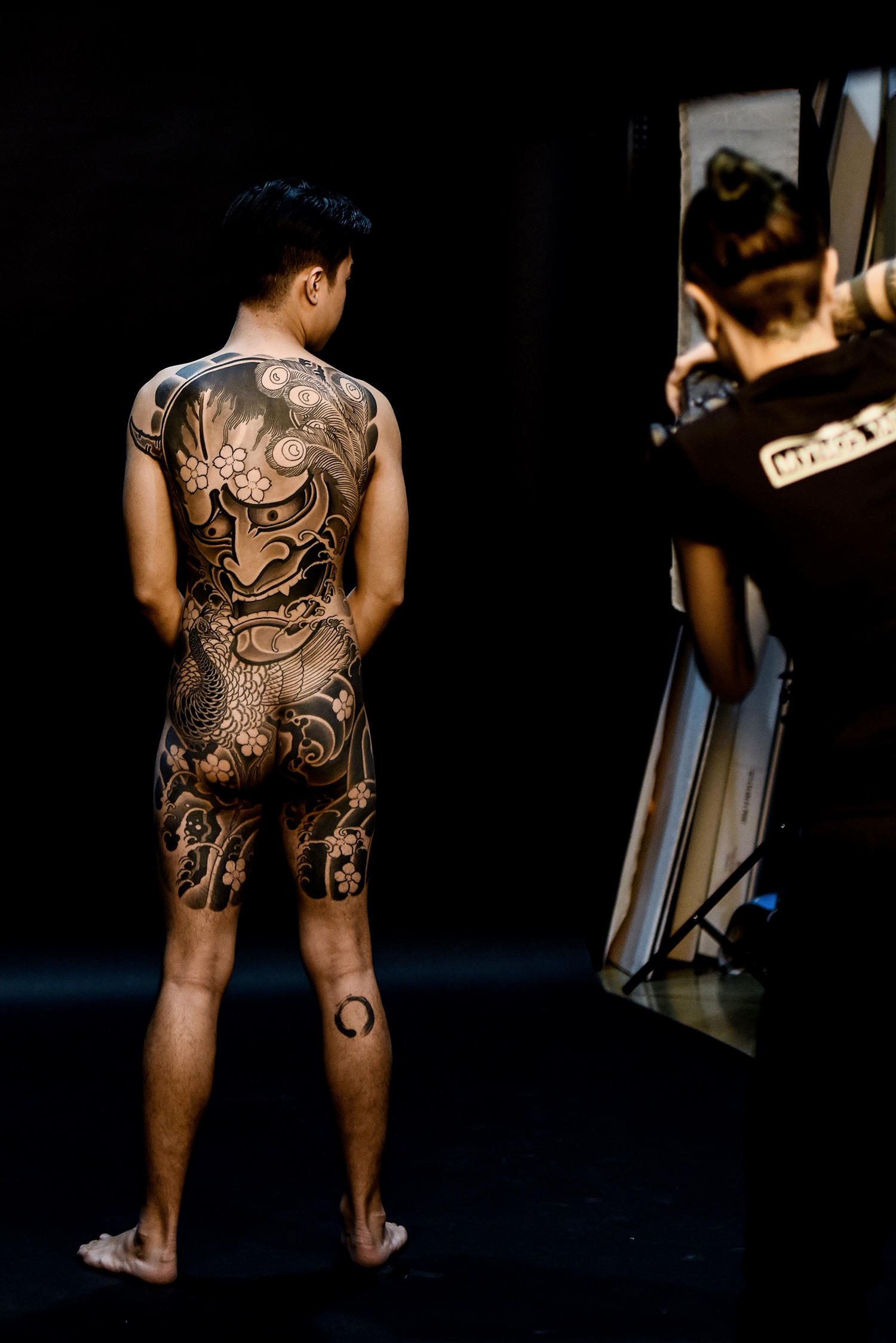
the 2017 Hannya back piece. Photo by Jana Yar.
Additionally, you are a regular traveler. With the pandemic, you remained in Singapore. How are you planning to spend the next year?
I sure as hell hope we can start traveling next year! This is the longest time I’ve been stuck in one city. I plan to start swimming to islands nearby if they still have all these travel restrictions. I’d swim to Bali or something. Maybe some island in Thailand, Haha! I need to get out of this concrete jungle. For now, I’ll probably work on finishing my book. Ruin more people’s futures with tattoos and maybe paint something? I miss painting a lot. I want to ease up on tattooing and set aside some time to paint.
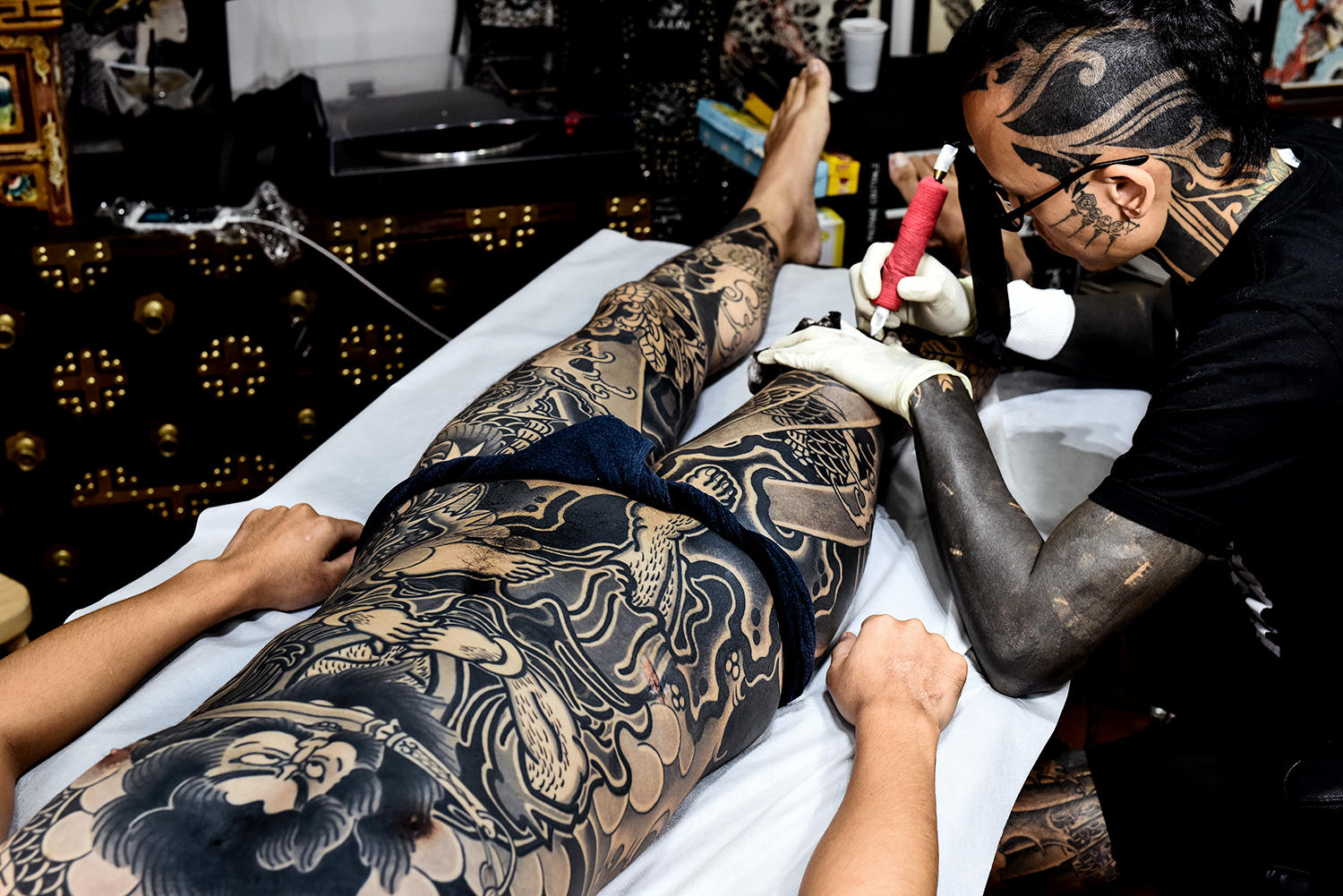
The development of the bodysuit — subject matter
Ju-unryu Kosonsho (torso) and Chrysanthemums (legs).
You’ve been commended for being a good father to your 6-year old son, Skyler. How do you strike a balance between job and family life?
Some may regard me as a terrible father because I let my kid skip school to go on adventures. I never did any homework with him properly; instead, I played games and read comic books. On YouTube, I let him watch punk bands like The Casualties and The Exploited. He’ll be able to tell what’s punk and what isn’t. I’m too much of a rascal to be considered good. But I do my best to be there for him and be his superhero or supervillain, as he sees fit. I make mistakes all the time, and I’m still learning how to be a father, but I believe I’m getting the hang of it. I need to make sure he’s safe, teach him kindness and compassion, and make him laugh as much as possible.
And, in terms of balancing work and family life, I make sure that when I’m in dad mode, I give it my all. I’ll force myself to disconnect from everything work-related and focus on family time. But I do get sidetracked from time to time. Because my job is also my hobby, I tend to overdo things and get carried away. Even when I’m exhausted, I make an effort to be present for him.
We certainly do a lot of fun things. In Singapore, we go on hikes and explore small pockets of nature. I used to bring him home on a bicycle with a child seat, but he’s getting heavier by the day, and my wrist injury has prevented me from doing so, so we’ve been spending a lot of time outside and at the beach.
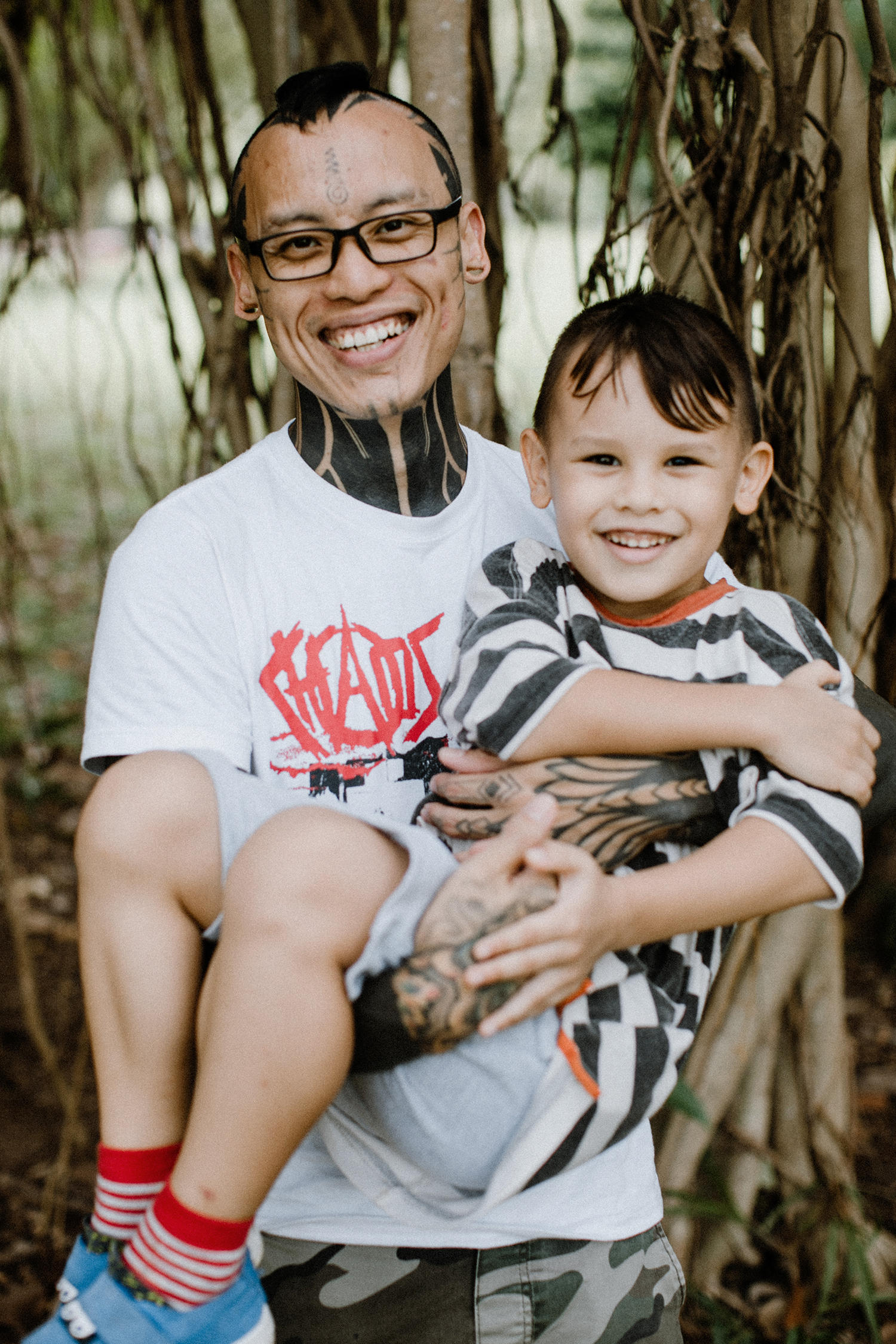
Shane Tan and son Skyler at the park.
Has your son shown a desire to learn about tattooing?
I’m not sure he’s as interested in tattoos as I was when I was his age. However, my son does not even give tattooed people a second glance or reacts differently to them. He grew up around tattooed people, so seeing someone with neck or facial tattoos is nothing out of the ordinary for him, but I’ve noticed he enjoys drawing on himself a lot, so that’s a good thing, right? He recently drew chin tattoos on himself with permanent markers. It was a series of thick black lines. It was too cute, and I couldn’t stop laughing.
I hope he does something creative in the future, but I will never compel him to do so. It is his life, and he makes the decisions. And if he develops an interest in tattooing, I’d be delighted to buy him his first machine so he can tattoo my clients while I sit back, relax, and watch him make a mess.
Behind the scenes photos by Jana Yar.
All other photos © Shane Tan
